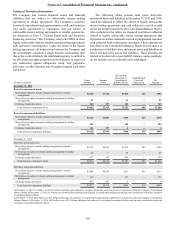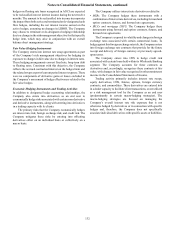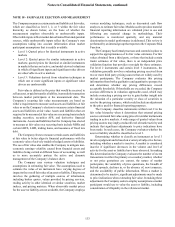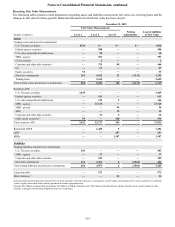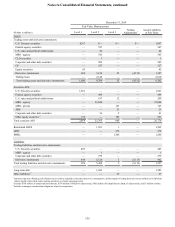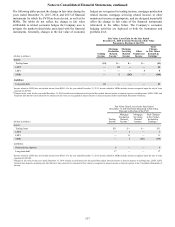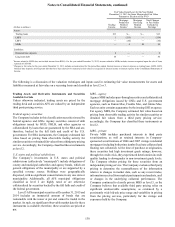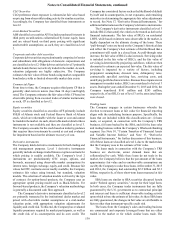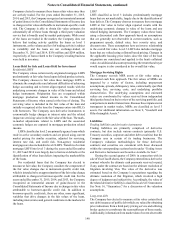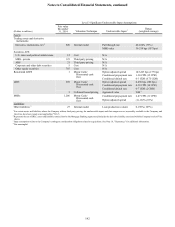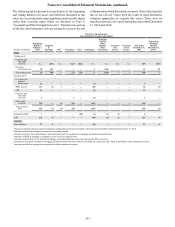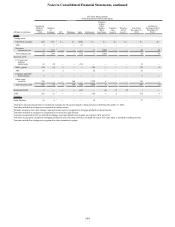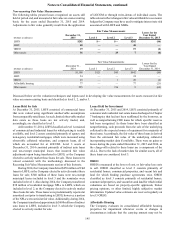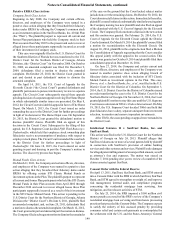SunTrust 2015 Annual Report Download - page 167
Download and view the complete annual report
Please find page 167 of the 2015 SunTrust annual report below. You can navigate through the pages in the report by either clicking on the pages listed below, or by using the keyword search tool below to find specific information within the annual report.Notes to Consolidated Financial Statements, continued
139
CLO Securities
CLO preference share exposure is estimated at fair value based
on pricing from observable trading activity for similar securities.
Accordingly, the Company has classified these instruments as
level 2.
Asset-Backed Securities
ABS classified as securities AFS includes purchased interests in
third party securitizations collateralized by home equity loans
and are valued based on third party pricing with significant
unobservable assumptions; as such, they are classified as level
3.
Corporate and other debt securities
Corporate debt securities are predominantly comprised of senior
and subordinate debt obligations of domestic corporations and
are classified as level 2. Other debt securities in level 3 primarily
include bonds that are not actively traded in the market. As such,
valuation judgments are highly subjective. The Company
estimates the fair value of these bonds using market comparable
bond index yields as limited observable market data exists.
Commercial Paper
From time to time, the Company acquires third party CP that is
generally short-term in nature (less than 30 days) and highly
rated. The Company estimates the fair value of this CP based on
observable pricing from executed trades of similar instruments;
as such, CP is classified as level 2.
Equity securities
Equity securities classified as securities AFS primarily include
FHLB of Atlanta stock and Federal Reserve Bank of Atlanta
stock, which are redeemable with the issuer at cost and cannot
be traded in the market. As such, observable market data for these
instruments is not available and they are classified as level 3.
The Company accounts for the stock based on industry guidance
that requires these investments be carried at cost and evaluated
for impairment based on the ultimate recovery of cost.
Derivative instruments
The Company holds derivative instruments for both trading and
risk management purposes. Level 1 derivative instruments
generally include exchange-traded futures or option contracts for
which pricing is readily available. The Company’s level 2
instruments are predominantly OTC swaps, options, and
forwards, measured using observable market assumptions for
interest rates, foreign exchange, equity, and credit. Because fair
values for OTC contracts are not readily available, the Company
estimates fair values using internal, but standard, valuation
models. The selection of valuation models is driven by the type
of contract: for option-based products, the Company uses an
appropriate option pricing model such as Black-Scholes. For
forward-based products, the Company’s valuation methodology
is generally a discounted cash flow approach.
The Company's derivative instruments classified as level 2
are primarily transacted in the institutional dealer market and
priced with observable market assumptions at a mid-market
valuation point, with appropriate valuation adjustments for
liquidity and credit risk. To this end, the Company has evaluated
liquidity premiums required by market participants, as well as
the credit risk of its counterparties and its own credit. The
Company has considered factors such as the likelihood of default
by itself and its counterparties, its net exposures, and remaining
maturities in determining the appropriate fair value adjustments
to record. See Note 17, “Derivative Financial Instruments,” for
additional information on the Company's derivative instruments.
The Company's derivative instruments classified as level 3
include IRLCs that satisfy the criteria to be treated as derivative
financial instruments. The fair value of IRLCs on residential
LHFS, while based on interest rates observable in the market, is
highly dependent on the ultimate closing of the loans. These
“pull-through” rates are based on the Company’s historical data
and reflect the Company’s best estimate of the likelihood that a
commitment will result in a closed loan. As pull-through rates
increase, the fair value of IRLCs also increases. Servicing value
is included in the fair value of IRLCs, and the fair value of
servicing is determined by projecting cash flows, which are then
discounted to estimate an expected fair value. The fair value of
servicing is impacted by a variety of factors, including
prepayment assumptions, discount rates, delinquency rates,
contractually specified servicing fees, servicing costs, and
underlying portfolio characteristics. Because these inputs are not
transparent in market trades, IRLCs are considered to be level 3
assets. During the years ended December 31, 2015 and 2014, the
Company transferred $161 million and $245 million,
respectively, of net IRLCs out of level 3 as the associated loans
were closed.
Trading loans
The Company engages in certain businesses whereby the
election to measure loans at fair value for financial reporting
aligns with the underlying business purpose. Specifically, the
loans that are included within this classification are: (i) loans
made, or acquired, in connection with the Company’s TRS
business, (ii) loans backed by the SBA, and (iii) the loan sales
and trading business within the Company’s Wholesale Banking
segment. See Note 10, "Certain Transfers of Financial Assets
and Variable Interest Entities," and Note 17, “Derivative
Financial Instruments,” for further discussion of this business.
All of these loans are classified as level 2, due to the market data
that the Company uses in the estimate of fair value.
The loans made in connection with the Company’s TRS
business are short-term, senior demand loans that are
collateralized by cash. While these loans do not trade in the
market, the Company believes that the par amount of the loans
approximates fair value and no unobservable assumptions are
used by the Company to value these loans. At December 31, 2015
and 2014, the Company had outstanding $2.2 billion and $2.3
billion, respectively, of these short-term loans measured at fair
value.
SBA loans are similar to SBA securities discussed herein
under “Federal agency securities,” except for their legal form.
In both cases, the Company trades instruments that are fully
guaranteed by the U.S. government as to contractual principal
and interest and there is sufficient observable trading activity
upon which to base the estimate of fair value. As these SBA loans
are fully guaranteed, the changes in fair value are attributable to
factors other than instrument-specific credit risk.
The loans from the Company’s sales and trading business
are commercial and corporate leveraged loans that are either
traded in the market or for which similar loans trade. The



